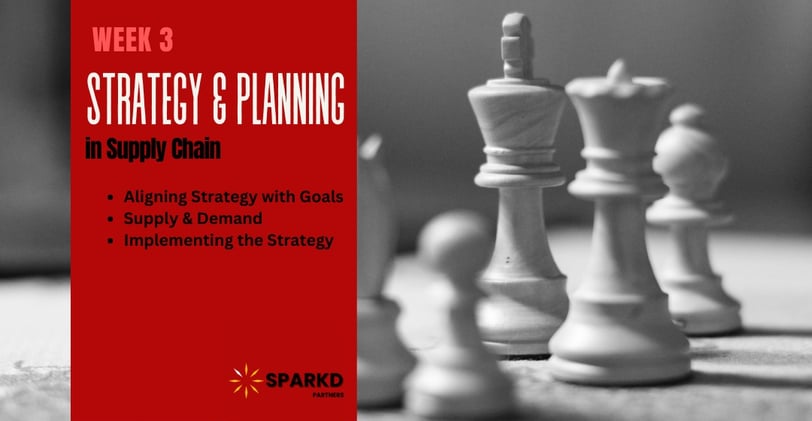Week 3: Supply Chain Planning
Supply chain planning involves several types of planning processes that are essential to ensure an efficient and effective supply chain. Organizations must also analyze customer behavior and preferences to develop strategies that meet and exceed customer expectations.


Supply Chain Planning
In the world of business, strategy and planning are essential for achieving success. This is particularly true when it comes to supply chain management, which involves the coordination of activities from sourcing to production and logistics to deliver products or services to customers.
Effective planning can help organizations anticipate and respond to changes in the market, optimize resources, reduce costs, and ultimately improve customer satisfaction.
Types of Supply Chain Planning
Sales and Operations Planning (S&OP)
Inventory planning
Capacity planning
Distribution planning
Supplier planning
Aligning Supply Chain Strategy with Business Goals
Understanding the organization's mission, vision, and objectives
Aligning the supply chain strategy with business goals
Prioritizing investments and resources
Identifying potential risks and opportunities
Developing contingency plans to mitigate risks and capitalize on opportunities
Understanding Supply and Demands
Analyzing customer behavior and preferences
Optimizing inventory levels, reducing lead times, and enhancing customer service
Engaging with customers to identify their pain points, preferences, and priorities
Collecting and analyzing customer data to tailor supply chain strategies accordingly
Implementing and Monitoring the Supply Chain Strategy
Setting up metrics to track performance
Identifying areas for improvement
Making changes as needed
Continuous improvement to maintain a competitive edge
Types of Supply Chain Planning:
Sales and Operations Planning (S&OP) is a critical area of focus. S&OP involves aligning sales forecasts with production plans and inventory levels. This helps businesses to balance supply and demand, avoid stockouts and excess inventory, and ensure that they are producing the right products at the right time.
Inventory planning is also important for effective supply chain management. Businesses need to determine optimal inventory levels to ensure product availability while minimizing excess inventory. This involves balancing the costs of carrying inventory against the costs of stockouts, and developing strategies to manage inventory across the supply chain.
Capacity planning involves determining the capacity needed to meet demand while balancing resources and demand. Assessing production capacity, staffing levels, and equipment needs to ensure that businesses can meet customer needs while remaining efficient and cost-effective.
Distribution planning is also critical to the success of supply chain management. Businesses need to determine the optimal distribution network to deliver products to customers. This includes assessing transportation options, determining optimal delivery routes, and managing warehousing and storage facilities to ensure timely delivery and customer satisfaction.
Lastly, supplier planning is essential to ensure a reliable supply of materials and components. This involves managing supplier relationships, assessing supplier capabilities, and developing contingency plans to address any supply chain disruptions that may arise.
Aligning Supply Chain Strategy with Business Goals
To be effective, a supply chain strategy must be aligned with the overall business goals. This involves understanding the organization's mission, vision, and objectives, as well as its competitive environment. By aligning the supply chain strategy with the business goals, organizations can improve efficiency, reduce costs, and increase customer satisfaction.
A well-defined supply chain strategy can help organizations prioritize investments and resources, such as technology and infrastructure, to achieve their business goals. It can also help organizations identify potential risks and opportunities in the supply chain and develop contingency plans to mitigate risks and capitalize on opportunities.
Develop strategies to improve your supply chain's ability to support your business goals. For example, if you identify that your delivery times are longer than competitors, you may need to invest in improving transportation networks or optimizing warehouse operations.
Understanding Supply and Demands
Analyzing customer behavior and preferences enables organizations to develop supply chain strategies that meet and exceed customer expectations, providing a competitive advantage. Through understanding customer needs and demands, organizations can optimize inventory levels, reduce lead times, and enhance customer service. This involves actively engaging with customers to identify their pain points, preferences, and priorities. By collecting and analyzing customer data, such as purchasing patterns, product reviews, and feedback, organizations can gain valuable insights into customer needs and use this information to tailor their supply chain strategies accordingly.
Implementing and Monitoring the Supply Chain Strategy
Once a supply chain strategy is developed, it must be implemented and monitored. This involves setting up metrics to track performance, identifying areas for improvement, and making changes as needed. Continuous improvement is essential to ensuring the supply chain is meeting business goals and responding to changes in the market environment.
Effective supply chain planning is critical to the success of any business. By understanding customer needs and demands, aligning supply chain strategy with business goals, and continuously monitoring and adapting to changes, organizations can optimize their supply chains and achieve greater success. Ongoing planning and adaptation are essential to maintaining a competitive edge in today's dynamic business environment
Struggling to write your team vision? Get some tips here.
Prefer to read it all in one go as a PDF? Get the 7-Step Supply Chain Crash Course here.


